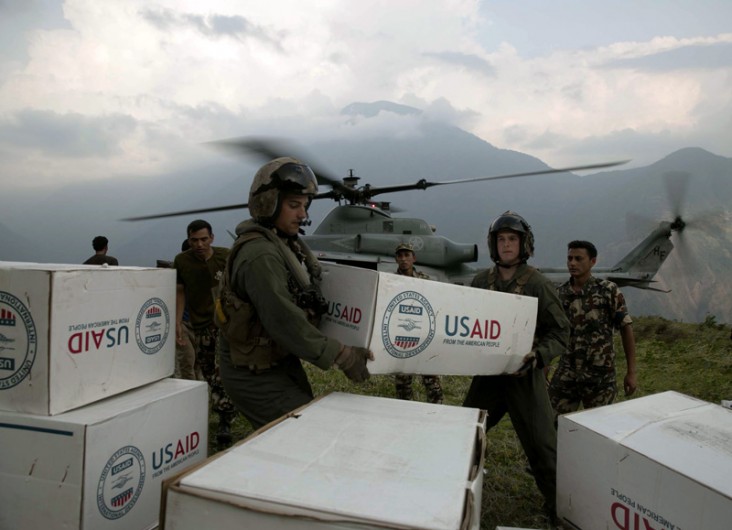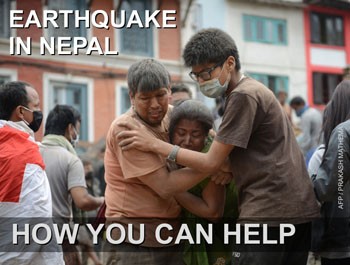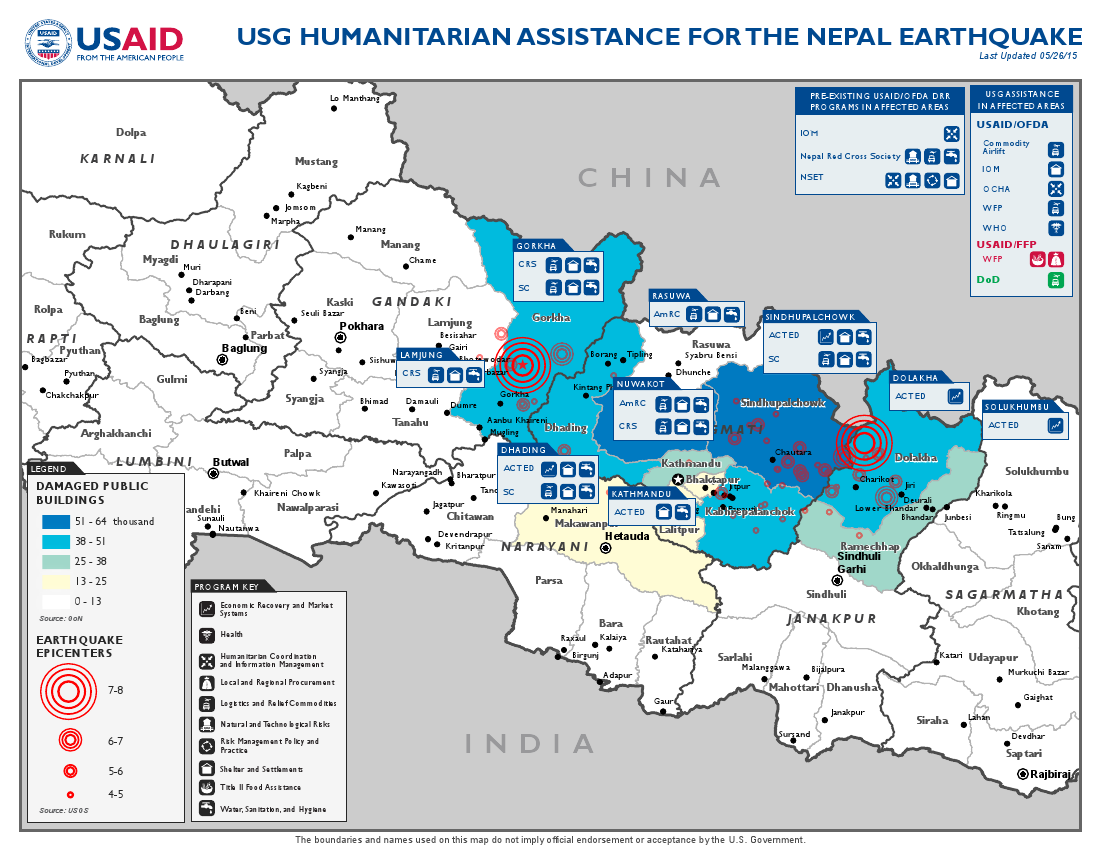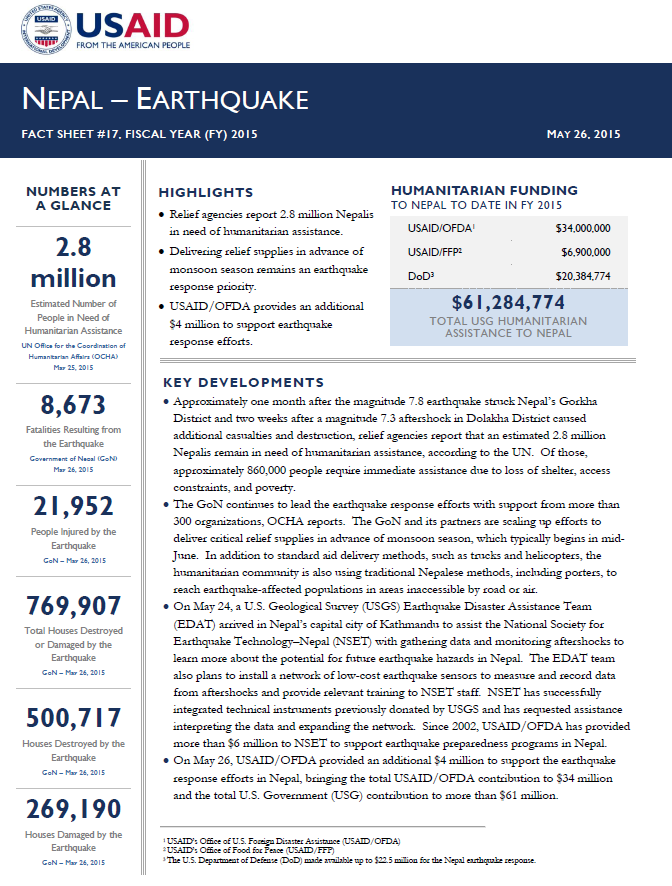May 26, 2015
Highlights
Relief agencies report 2.8 million Nepalis in need of humanitarian assistance.
Delivering relief supplies in advance of monsoon season remains an earthquake response priority.
USAID/OFDA provides an additional $4 million to support earthquake response efforts.
Key Developments
Approximately one month after the magnitude 7.8 earthquake struck Nepal’s Gorkha District and two weeks after a magnitude 7.3 aftershock in Dolakha District caused additional casualties and destruction, relief agencies report that an estimated 2.8 million Nepalis remain in need of humanitarian assistance, according to the UN. Of those, approximately 860,000 people require immediate assistance due to loss of shelter, access constraints, and poverty.
Nepal Earthquake Map - May 26, 2015 ![]() (pdf - 967k)
(pdf - 967k)
Numbers At A Glance
2.8 million
8,673
21,952
769,907
500,717
269,190
Humanitarian Funding:
To Nepal To Date In FY2015:
| USAID/OFDA | $34,000,000 |
| USAID/FFP | $6,900,000 |
| DoD | $20,384,774 |
| TOTAL | $61,284,774 |
Nepal Earthquake Fact Sheet #17 - 05-26-2015 ![]() (pdf - 192k)
(pdf - 192k)
The GoN continues to lead the earthquake response efforts with support from more than 300 organizations, OCHA reports. The GoN and its partners are scaling up efforts to deliver critical relief supplies in advance of monsoon season, which typically begins in mid-June. In addition to standard aid delivery methods, such as trucks and helicopters, the humanitarian community is also using traditional Nepalese methods, including porters, to reach earthquake-affected populations in areas inaccessible by road or air.
On May 24, a U.S. Geological Survey (USGS) Earthquake Disaster Assistance Team (EDAT) arrived in Nepal’s capital city of Kathmandu to assist the National Society for Earthquake Technology–Nepal (NSET) with gathering data and monitoring aftershocks to learn more about the potential for future earthquake hazards in Nepal. The EDAT team also plans to install a network of low-cost earthquake sensors to measure and record data from aftershocks and provide relevant training to NSET staff. NSET has successfully integrated technical instruments previously donated by USGS and has requested assistance interpreting the data and expanding the network. Since 2002, USAID/OFDA has provided more than $6 million to NSET to support earthquake preparedness programs in Nepal.
On May 26, USAID/OFDA provided an additional $4 million to support the earthquake response efforts in Nepal, bringing the total USAID/OFDA contribution to $34 million and the total U.S. Government (USG) contribution to more than $61 million.
HUMANITARIAN ACCESS AND LOGISTICS
Landslides triggered by aftershocks and pre-monsoon rains continue to pose a significant threat to earthquake-affected populations and hinder relief operations. The UN notes that many of the people most affected by the April 25 earthquake and aftershocks reside in areas that are highly vulnerable to floods and landslides, creating an urgent need to provide humanitarian assistance before the monsoon rains begin—typically in mid-June.
The UN estimates that 315,000 people in Nepal’s 14 most-affected districts remain inaccessible by road, including approximately 75,000 people that also cannot be reached by air. To access these populations, relief agencies are identifying ways to supplement traditional aid delivery methods, including trucks and helicopters, with creative solutions, such as using elite climbers and up to 20,000 porters to establish a supply chain to reach remote villages. A local trekking association will likely manage the porters, each of whom could carry up to 30 kilograms—approximately 66 pounds—of relief supplies per trip. Porters have already begun assisting the UN World Food Program (WFP) with food distributions, including in northern areas of Gorkha.
To date, the Logistics Cluster—the coordinating body for humanitarian logistics activities, comprising UN agencies, non-governmental organizations (NGOs), and other stakeholders—has established five logistics hubs across earthquake-affected districts of Nepal to expedite relief and recovery efforts. Cluster partners are conducting aerial assessments of mountain trails and report plans to establish additional hubs in the coming weeks to support the porters providing last-mile distribution of relief supplies in hard-to-reach areas.
A new helicopter landing zone at the Chautara logistics hub in Sindhupalchowk District became operational on May 20 and facilitated the delivery of emergency food, shelter materials, and hygiene kits to nearby villages. Relief agencies anticipate that the humanitarian response in Nepal will remain heavily dependent on aircraft in the coming months due to access challenges. To date, the UN Humanitarian Air Service reports completing nearly 330 missions, transporting more than 480 humanitarian personnel and nearly 140 metric tons (MT) of cargo.
The GoN and relief agencies are communicating with populations in Nepal’s 14 most-affected districts through dedicated humanitarian programming on more than 350 radio stations. The radio programs provide information regarding self-help strategies and ways to access assistance and encourage community participation through call-in programs and text messaging, according to OCHA.
DISPLACEMENT AND SHELTER
The GoN reports that the April 25 earthquake and aftershocks have damaged or destroyed nearly 770,000 houses, directly impacting the lives and livelihoods of an estimated 3.8 million people. Of those, relief agencies estimate that 2.8 million Nepalis remain in need of humanitarian assistance, including approximately 860,000 people in need of immediate assistance due to loss of shelter, access constraints, and poverty, according to OCHA.
Under the revised Nepal Earthquake Flash Appeal—scheduled for release on May 29—the Shelter Cluster’s short-term goal is to reach 350,000 vulnerable households with emergency shelter assistance, prioritizing at-risk groups in hard-to-reach areas by the end of July. If the revised appeal is fully funded, the cluster expects to be able to meet this goal, as well as support the self-recovery of approximately 150,000 additional households.
As of May 20, the GoN had distributed nearly 230,600 of the more than 622,700 tarpaulins ordered to assist disaster-affected populations throughout Nepal, according to the Shelter Cluster. Additionally, relief agencies had distributed more than 217,300 tarpaulins as of May 23, and approximately 483,800 tarpaulins remained in the pipeline.
To date, USAID/OFDA has airlifted 6,200 rolls of plastic sheeting to Nepal to provide emergency shelter assistance for approximately 62,000 earthquake-affected households—up to 310,000 people. As of May 25, USAID/OFDA partner the International Organization for Migration (IOM) had disseminated all 6,200 rolls of plastic sheeting to various humanitarian organizations for distribution to earthquake-affected households.
The first round of IOM’s Displacement Tracking Matrix (DTM) assessment identified 262 displacement sites across 142 villages in 14 districts of Nepal. In preparation for the monsoon season, Camp Coordination and Camp Management Cluster partners are advocating for support to improve site conditions in a number of priority displacement sites identified by the GoN, including 16 sites in Gorkha and Sindhupalchowk. IOM conducted a second round of assessments between May 21 and 23 in Kathmandu Valley; the findings will provide updated information on the present use of the 83 open spaces identified by IOM prior to the earthquake.
REACH—a joint initiative between NGOs the Agency for Technical Cooperation and Development (ACTED) and IMPACT Initiatives and the UN Operational Satellite Applications Program—recently completed shelter assessments in four districts and plans to complete assessments in four additional districts by May 27. The Shelter Cluster anticipates completing assessments in all 14 of the most-affected districts by June 8.

INTERNATIONAL ASSISTANCE
The clusters operating in Nepal are currently revising their response plans, and the Humanitarian Country Team expects to release an updated Nepal Earthquake Flash Appeal on May 29. To date, the USG has provided more than $61 million for earthquake response and recovery efforts in Nepal, while other international donors have provided nearly $245 million. Of the more than $306 million provided, approximately $97 million—32 percent—supported the current $423 million flash appeal.
CONTEXT
On April 25, a magnitude 7.8 earthquake struck central Nepal’s Gorkha District, approximately 77 kilometers (km) northwest of Kathmandu, at a depth of approximately 15 km, according to the U.S. Geological Survey (USGS).
The USG immediately issued a disaster declaration for Nepal due to the effects of the earthquake. Within hours of the seismic event, USAID/OFDA activated a Response Management Team (RMT) in Washington, D.C., and deployed a DART—including urban search-and-rescue specialists—to support emergency response efforts in Nepal.
On May 12, a magnitude 7.3 aftershock struck Nepal’s Dolakha District, approximately 76 km northeast of Kathmandu, according to USGS. The aftershock caused further casualties and damages in areas affected by the April 25 earthquake.
For nearly two decades, USAID/OFDA has supported disaster risk reduction (DRR) efforts in Nepal, including throughout Kathmandu Valley. USAID/OFDA funding has enabled partners to identify, prepare, and preserve more than 80 open spaces in Kathmandu Valley for humanitarian purposes; pre-position critical emergency relief supplies; and strengthen earthquake response capacity at the local and national levels in collaboration with the GoN, non-governmental organizations, private companies, and local communities. More information on USAID/OFDA’s DRR programs in Nepal and throughout South Asia is available at www.usaid.gov/what-we-do/working-crises-and-conflict/disaster-risk-reduc....
PUBLIC DONATION INFORMATION
The most effective way people can assist relief efforts is by making cash contributions to humanitarian organizations that are conducting relief operations. A list of humanitarian organizations that are accepting cash donations for disaster responses around the world can be found at www.interaction.org.
USAID encourages cash donations because they allow aid professionals to procure the exact items needed (often in the affected region); reduce the burden on scarce resources (such as transportation routes, staff time, and warehouse space); can be transferred very quickly and without transportation costs; support the economy of the disaster-stricken region; and ensure culturally, dietary, and environmentally appropriate assistance.
More information can be found at:
- The Center for International Disaster Information: www.cidi.org or +1.202.821.1999.
-
Information on relief activities of the humanitarian community can be found at www.reliefweb.int.










Comment
Make a general inquiry or suggest an improvement.